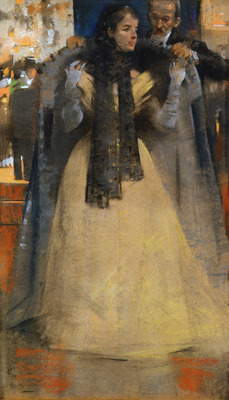Arthur Melville A.R.S.A., R.W.S., R.S.W. (1855-1904)
After the play
Coloured chalks on paper
Signed.
39 x 23 ins (99 x 58.4 cm)
SOLD
Provenance
Collection of Mrs Lake, 1965
Collection of Mr Andrew McIntosh Patrick
Collection of Giorgio Marsan and Umberta Nasi
Exhibited
First Exhibition of the Society of British Pastellists, The Grosvenor Gallery, London, 1890, no. 21
Let Glasgow Flourish, The Fine Art Society, Glasgow, 1979, no. 97
Spring Exhibition, The Fine Art Society, London, 1987, no.12
Arthur Melville Exhibition, Bourne Fine Art, Edinburgh & The Fine Art Society, London, October 1996, no. 35 (on loan)
The Glasgow Boys, 1885 - 1895, Bourne Fine Art, Edinburgh & The Fine Art Society, London, August - October 2004, no.3 (illustrated)
Following upon the international acclaim for the Glasgow Boys in the early part of 1890, Melville was to pass the rest of the summer chiefly preoccupied with the completion of the large pastel After the Play - a tour de force, which he showed in the autumn at The Grosvenor Gallery's inaugural exhibition of the British Pastellists.
After the Play is an exciting composition in the exercise of colour harmony. The bold expanse of the bright yellow dress of the woman being helped into her cape dominates the picture. Here Melville is dealing with a notion far in advance of his time - the reaction of colour planes against each other to express space within the picture.
